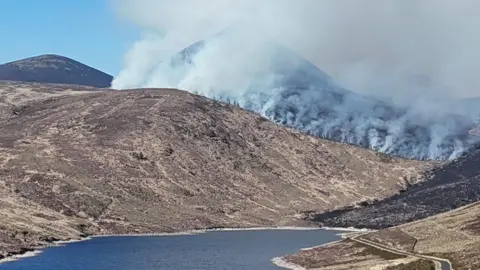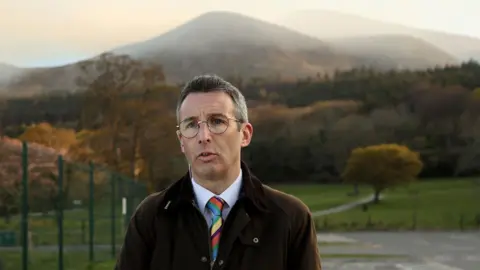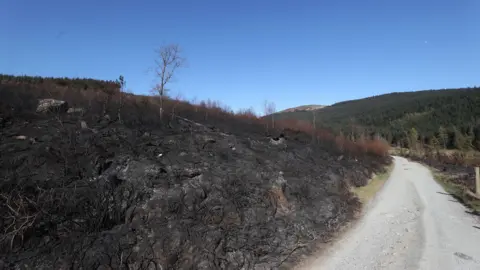Mournes: ‘Decades of impact to come’, conservationist says
April 8, 2025
‘Decades of environmental impact’ from Mournes blaze
 PA Media
PA MediaThe environmental impact of recent fires on the Mourne Mountains will be seen for decades, a conservationist has said.
Vincent McAlinden, who lives and works in the area, said the fires escalated to a “catastrophic devastation”.
The Northern Ireland Fire and Rescue Service (NIFRS) is still dealing with two fires – one at Bloody Bridge and the other at Trassey Track near Newcastle, County Down.
A major incident was declared at the weekend when a large wildfire broke out near the Mourne Mountains, and led to homes being evacuated. That blaze is being treated as arson. There have been 147 blazes across the mountains since Thursday night.
‘The beating heart of the Mournes’
On Monday night more than 60 officers attended several blazes in the Mourne Mountains – including the Bloody Bridge fire front near Newcastle stretching one-and-a-half kilometres.
The fire service were also at the scene of wildfires at Sawel Mountain in Newtownstewart, Carncullagh Road in Dervock, and another at Silent Valley near Kilkeel.
NIFRS Area commander David Harbison said a Sandbank Road fire was “one of the most significant wildfires” he had witnessed in 25 years.
“Inside the beating heart of the Mournes is in really, really bad shape,” Mr McAlinden told BBC Radio Ulster’s Good Morning Ulster programme.
He explained the environmental impact of the wildfires.
“It’s basically the utter incineration of the living skin that provides all the public good that we benefit from.
“Spring is supposed to be a time of renewal, things emerge, buds burst, birds sing – that’s all gone, it’s dead.
Yellow wildfire warning
 PA Media
PA MediaA national hazards management yellow wildfire warning remains in place across Northern Ireland.
“Some animals would have been able to move in front of the fire but most won’t and certainly anything that’s young or anything that’s been in hibernation or small is now just dead,” Mr McAlinden said.
 PA Media
PA MediaResponding to an urgent question in the NI Assembly on Monday, Minister for Agriculture, Environment and Rural Affairs Andrew Muir described the wildfires in the Mourne Mountains as “rural arson”.
Muir, who visited the area on Monday evening, said the unfolding situation “is really concerning”.
Muir said a strategic wildfire group was established following the 2021 fire, which identified a need for a wildfire management plan for a number of areas, including the Mournes.
“We went to tender on that in the beginning of this year and unfortunately we didn’t get any successful responses. That perhaps demonstrates this is an issue beyond Northern Ireland,” he said.
‘Just charcoal’
 PA Media
PA MediaMr McAlinden added that the aftermath will be felt even after the fires are extinguished.
“It’s just charcoal, the wind has abetted but when it picks up again it will just blow all that charcoal away and back into the streams, back into the air,” he said.
Where are the Mourne Mountains?
The Mourne Mountains are located in County Down and are designated as an Area of Outstanding Natural Beauty.
A compact range, they include Northern Ireland’s highest peak, Slieve Donard, and a dozen or so other major summits.
Large tracts are held in public ownership, but significant sections are privately-owned farmland.
Northern Ireland Water is one of the biggest landowners in the mountains and purchased 9,000 acres in the 1900s to secure a supply of drinking water for the growing city of Belfast.
The National Trust is another significant landowner.
Search
RECENT PRESS RELEASES
Related Post




